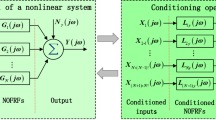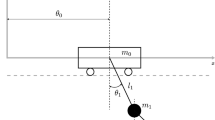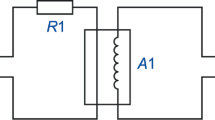We consider the problem of the concurrent identification of a linear dynamic measuring system with an unknown input signal under the influence of various destabilizing factors on the system parameters. Solution of this problem will reduce the error of measuring systems in the dynamic measurement mode. To perform the identification, we introduce an additional channel for the transformation of the measured value in the spatial domain; this operator satisfies the condition of non-commutativity with the operator of the system under study. The concurrent identification problem is solved for the linear dynamic characteristic of the main channel of a first-order measuring system. To exclude incorrect operations when differentiating the output signals of a structurally redundant measuring system (SRMS), in the process of concurrent identification the method of modulating functions is used. We present the dependence of the mean square deviations of the reduced input estimation error on the number of measurements during identification for various levels of the standard deviation of the measurement noise, reduced to the input signal scale, as well as on the sampling rate of output signals of a structurally redundant measuring system. The sampling rate determines the size of the observation sample formed during digital processing of the system output signals in a computing device. It is shown that the highest identification accuracy is achieved with a quadratic transformation of the input signal in an additional channel of a structurally redundant measuring system, and the selection of a modest sampling rate of output signals increases the stability of the identification algorithm. In this case, the dependence of the standard deviation of the reduced input estimation error on the sampling rate of the output signals of a structurally redundant measuring system has a minimum. Research results can be used to improve the accuracy of measuring systems in dynamic measurement mode, as well as to enable automatic metrological control of intelligent measuring systems.




Similar content being viewed by others
References
L. Ljung, Systems Identification: Theory for the User [Russian translation], Nauka, Moscow (1991).
A. N. Diligenskaya, Identification of Control Objects, Samara State Technical University, Samara (2009).
N. N. Karabutov, Structural Identification of Systems: Analysis of Dynamic Structures, MGIU, Moscow (2008).
E. E. Bagdatiev and Yu. N. Chernyshov, Sensor Equipment for Information-Measuring Systems, Moscow State Forest University, Moscow (2008).
A. I. Loskutov (ed.), Telemetry, VKA im. Mozhaiskogo, St. Petersburg (2017).
G. I. Kozyrev (ed.), Modern Telemetry in Theory and Practice. Training Course, Nauka i Tekhnika, St. Petersburg (2007).
V. B. Belorusets, “Method of auxiliary systems for identifying dynamic objects with an unknown input signal,” Avtomat. Telemekh., No. 8, 76–82 (1981).
V. B. Belorusets and M. Efimchik, “Identification of linear stationary systems with an unknown input action,” in: Statistical Problems of Control, Izd. Inst. Mat. Kibern. AN Lit. SSR, Vilnius (1979), Iss. 41, pp. 49–56.
G. S. Britov and L. A. Mironovskii, “Redundancy criteria for dynamical systems,” Izv. AN SSSR, Ser. Tekhn. Kibern., No. 1, 149–155 (1980).
K. G. Kiryanov, “Identifi cation of dynamic information characteristics of multichannel systems based on optimal data discretization,” Proc. 9th Int. Conf. Identification of Systems and Control Tasks, IPU RAN im. Trapeznikova, Moscow, Jan. 30 – Feb. 2, 2012, pp. 252–265.
A. N. Tikhonov, A. V. Goncharskii, V. V. Stepanov, and A. G. Yagola, Numerical Methods for Solving Ill-Posed Problems, Kniga po Trebovaniyu, Moscow (2012).
M. M. Shumafov and R. Tsei, “The method of modulating functions and its application in solving inverse problems,” Vestn. Adyg. Gos. Univ, Ser. 4, Est.-Mat. Tekhn. Nauki, No. 9 (2008).
G. I. Kozyrev, Methods of Identification of Means of Telemetry under the Influence of Uncertain Destabilizing Factors, VKA im. Mozhaiskogo, St. Petersburg (1996).
S. T. Kalenik, G. I. Kozyrev, and V. P. Obruchenkov, Invent. Certif. USSR No. 1674200, “Telemetric device.”
G. I. Kozyrev, A. V. Nazarov, V. S. Soldatenkov, and V. D. Usikov, “Synthesis of intelligent sensors using minimum structural redundancy,” Izmer. Tekhn., No. 11, 22–27 (2020), https://doi.org/10.32446/0368-1025it.2020-11-22-27.
Author information
Authors and Affiliations
Corresponding author
Additional information
Translated from Izmeritel’naya Tekhnika, No. 12, pp. 8–12, December, 2021.
Rights and permissions
About this article
Cite this article
Kozyrev, G.I., Kleimenov, Y.A. & Usikov, V.D. Method for Concurrent Identification of a Linear Dynamic Measurement System Based on Preliminary Nonlinear Transformation of the Input Signal. Meas Tech 64, 949–953 (2022). https://doi.org/10.1007/s11018-022-02027-2
Received:
Accepted:
Published:
Issue Date:
DOI: https://doi.org/10.1007/s11018-022-02027-2




